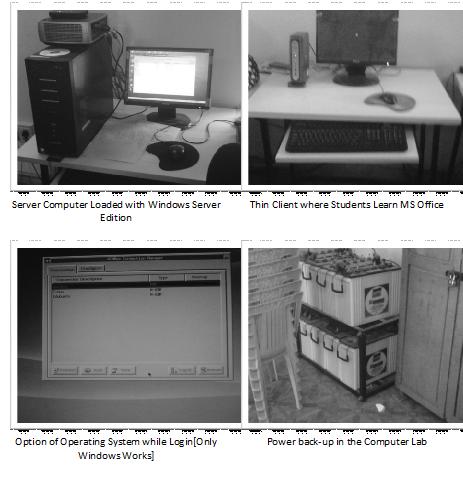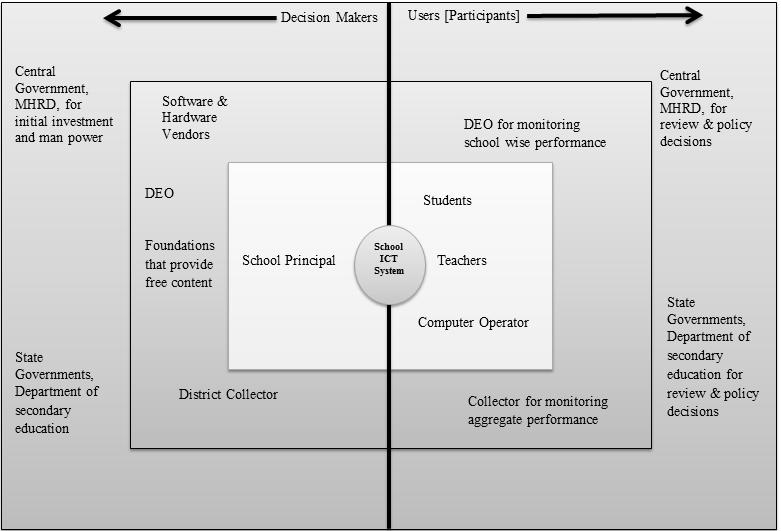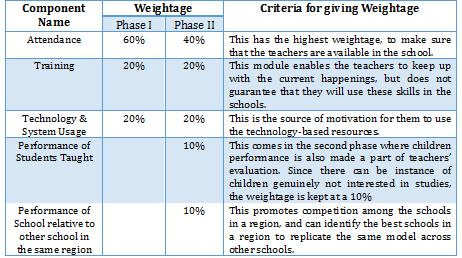Framework for Effective usage of ICT in Educational Ecosystems
Student Contributors : Bodavula Vikram and Venkata Seshagiri Rao
This article aims to present a scalable Information and Communications Technologies (ICT) education model covering three key elements – robust technology and infrastructure, clear business model and a focused organization. As part of their study, the authors looked into the current outsourced ICT system in Karnataka and analysed the implementation mechanism. They identified the potential issues that could affect the efficiency of the current system, and proposed a new ICT model. They expect that the proposed new model, by using infrastructure efficiently and by raising quality of education would improve the effectiveness of Indian education ecosystem significantly.
1 Introduction
One of the key challenges faced by developing countries like India is providing access to quality education at an affordable cost. A carefully designed Information and Communications Technologies (ICT) system for education can expand access to education, and raise educational quality by making teaching and learning into an engaging, active process connected to real life.
There are 25979 Lower Primary, 33619 Higher Primary and 13866 High Schools in the state of Karnataka. The central government of India is supporting the state governments in setting up ICT infrastructure in all the High Schools in a phased manner. The technology infrastructure, which is part of these ICT initiatives, also helps in carrying out routine work like printing scorecards and classroom schedules. However, is this all such an expensive and functional infrastructure can achieve? Are the current computing capabilities at least used to 10% of their actual potential? Is the lack of a proper model to exploit the benefits the computing power a problem? Is the lack of proper human capital to run the systems causing the problem? Do we have a better alternative to use such infrastructure? We examined all these questions and proposed an ICT education model that can improve the effectiveness of education in government schools.
2 Current ICT in Karnataka Education
In Karnataka, the Department of Public Instructions (DPI) controls and coordinates major activities at all stages of school education. We looked at the current system in terms of the three key elements for building a scalable and successful ICT system – Robust Technology and Infrastructure, Clear Business Model and a Focused Organization.
2.1 Technology and Infrastructure
The state currently has the necessary equipment needed for successful delivery of services – computers [hardware], software, internet connectivity [urban areas], training content [NGO’s and Government]. However, there is a need for optimal use of the ICT in education delivery.
2.2 Business Model
The state of Karnataka employs an outsourcing model called 'Mahiti Sindhu', a fully state-funded project where backward class students of rural areas and girls are given special emphasis. In this model, teachers play a minimal role in the computer based learning, and support staff or external vendors facilitate the learning process. The three external agencies - NIIT, Educomp and Aptech take the responsibility to set up ICT infrastructure in the schools. Exhibit 1 demonstrates the Computer Center set up by Educomp at one of the secondary schools in Jayanagar Bangalore. Since NIIT is into computer education as well, it has an additional contract for developing training content. The objective of the government is to impart quality computer education to students where the objective of the companies is to maximize the profits. Due to this conflict of interest, the effectiveness of the ICT infrastructure remains questionable. Further, there are issues related to teacher training modules and the ICT curriculum.
 Exhibit 1 Current State of Computer Labs
Exhibit 1 Current State of Computer Labs
2.3 Organization
The key stakeholders involved in the decision making process are Director, Department of State Educational Research and Training (DSERT); Director, Karnataka—Department of Education; Academic Head ICT; Head, Technology for Education. It is difficult to segregate the above functional heads into Business and IT departments since there is no information if all these stakeholders look into the ICT system with an executive or IT orientation.
3 Proposed ICT Framework
The proposed new scalable ICT framework can use the existing infrastructure available in the schools and the government CSC’s for effective delivery and monitoring of school performance.
3.1 Proposed Model
Exhibit 2 depicts the schematic diagram of the model and Exhibit 3 shows the corresponding stakeholders in the system. This model relies on a scalable software application, represented by the Main School Application in the Exhibit 2. The application will have multiple views based on the kind of the user that logs in to the system. Different stake holders will have access to different content based on their decision rights as shown in the stake holders’ Exhibit 3.There are two important views in this model. One is the internal view, which is accessible at the school level, and an external view that will take the data from the central server to give informative graphics to multiple users based on their access rights. Both are views are discussed below.
 Exhibit 2 High Level Architecture of the Model
Exhibit 2 High Level Architecture of the Model
 Exhibit 3 Stake Holders in the Model
Exhibit 3 Stake Holders in the Model
3.2 Internal View
This is the view in which the school has access to many modules to automate most of the work and enable real time transmission of data effectively increasing the velocity of decision-making. Though this model contains many modules at the school interface view, not all the modules go into the phase I of the implementation. Since the production cost of software is one time and the initial application is scalable, the marginal cost of deploying the additional modules across all the schools is close to zero. Deploying modules, in the order of the priority of the services, results in effective delivery. The modules’ description is below.
3.2.1 School Attendance Recording Module
This module would require additional hardware for getting the accurate information related to both teachers as well as students’ attendance. A low cost combination of Biometric and GPS device is proposed to be developed which will solve the fake identity problem since it is biometric based and also the fake presence problem using the GPS chip. The first layer in the three layered approach already discussed is reducing the absenteeism of the teachers. This module along with the Teacher Composite Score [refer section 4] will help solve this major issue.
To be implemented in Phase I, Priority Level 1
3.2.2 Teacher Training Module
This module helps the teachers attain relevant and latest skills required to impart the best possible knowledge to the students. Though currently government spends close to rupees 2300 crore on in-service teacher trainings, the effectiveness of such trainings is in question. The usage of existing school computers to train/test the teachers during their free hours will save considerable amount of money to the government and can help teachers utilize their time efficiently. Either the content is Audio/Visual or live interaction, wherein depending upon the internet connectivity live interaction is added in the later stages.
To be implemented in Phase I, Priority Level 2
3.2.3 School Management Information System Module [SMIS]
In the current system, teachers do all the MIS related work manually. For example, a computer based classroom schedule implemented by the proposed model can better allocate resources based on linear programming models than a human can when the number of resources is large.
To be implemented in Phase I, Priority Level 2
3.2.4 Mid-Day Meals Module
A major chunk of the money that government spends for school education goes to the mid-day meals scheme. In reality, there is large scale discrepancies in the statistics presented to the government and actual students served. This module can effectively reduce the pilferage if biometric attendance during the meals is compulsory. This will give an accurate as well as real time picture of the effectiveness of the scheme in retaining the students.
To be implemented in Phase II, Priority Level 1
3.2.5 Students Performance Recording Module
From the interaction with the computer lab operator in the school the team found out that although the students marks are being uploaded into an excel document, they are just being printed and mailed [Physical post] to the DEO’s office [Refer Appendix 2]. The proposed model will help capture the data into an application that has the capability to give different views to different stakeholders to observe trends and spot bottlenecks. Using this approach the system avoids delay in transmission of data.
To be implemented in Phase II, Priority Level 2
3.2.6 School Administration Module
This module captures the day-to-day functioning of the school activities and automates them. The school children enrolment, drop-out, transfers, data related to teachers, interaction with higher authorities [instead of paper mails we can use application based communication] etc. are captured in this module. This reduces the time lags and provides a real time picture on the needs on issues at every school to the higher levels in the Model.
To be implemented in Phase III, Priority Level 1
3.2.7 School Request Workflow
Currently any request from the school to the District/Taluk Education Officer flows through a paper based application. The proposed model aims to develop a workflow management system from the bottom layer up to the secretary level in the central/state governments where in paper based work is no longer required. Typical usage of workflow include leave requests, budget requests, requests for additional staff, special training programs based on the local needs, approval for events etc.
To be implemented in Phase III, Priority Level 2
3.3 External Views
The model by design, stores all the data in a central server. It can provide multiple views to different stakeholders to aid them in making decisions. These different views are as shown in Exhibit 2, and are as explained below.
3.3.1 View to the School Principal
The school principal is the person who can make a great difference in the effectiveness of the current education system. With this model, he/she can closely monitor all the data on a daily/monthly basis, compare data across years and take decisions that can improve the situation. He/She can get a comprehensive view of the entire school and interact with taluk/district administration on a real time basis.
3.3.2 View to the Taluk /District Education Officer
The taluk/district education officer has the mandate to check the facilities and monitor the performance of schools in their locality. The government is spending a lot of money for providing the necessary infrastructure, which include automobiles. The current system has many deficiencies like lack of real time data, delays in compilation of data that DEO wanted, intentional/accidental loss of data. The proposed model solves all these problems. It would also decrease the expenditure required for regular visits and paper based transactions. The view to taluk/district education officer will be school specific, which will enable them to take decisions regarding each individual school based on its resources and performance.
3.3.3 View to the District Collector
The district collector will get a comprehensive view of all the schools present in the district. He/she will get a trend based charts which aggregate data from all the schools, and can take policy decisions or request for inputs from TEO’s/DEO’s based on the overall trends.
3.3.4 View to the Training Content Institutes & Service Staff
The view to the training content developer will help identify the current skill level of the teacher based on the ease with which trainings are completed. It also provides inputs on the changes required in the content so as make it more convenient for the teachers to learn and teach.
A dedicated view is also created to the service staff/developer team, to analyse the system usage patterns, identifying the peak schedules, remote pushing of updates to the applications, remote text/AV based support etc.
3.3.5 View to the Minister/Secretary of School Education
This is the last level in the decision making process and needs a comprehensive view of the entire state/country. The data aggregated from all the schools undergoes categorization at district level to compare the performance and target specific schools/areas in the education system. This will also enable them measure the effectiveness of various programs and help them make informed choices about the funding required for various projects.
4 Improving Teacher Accountability
Teachers are the backbone for a delivering quality education. One of the key issues faced by the government schools is the accountability of teachers, and this issue needs more attention.
4.1 Teacher Composite Score [TCS Index]
The current system does not provide any incentives for teachers who make an extra effort to bring out the best of the students. Our model tries to solve this problem with the creation of an index for teacher evaluation called Teacher Composite Score [TCS]. This index depends on the performance across several categories as listed in the Exhibit 4. The index weight division is different in both the phases. In the first phase, we believe that it is more important to get the teachers into the school [improving attendance] even before considering the effectiveness of the delivery. Based on this view, ‘attendance of the teachers’ factor is assigned weightage. The second phase implementation happens when the system is more mature and this includes implementation of most of the modules in the main model. This will allow the local/district administration to compare the performances and rate the teachers. In addition, lesser weightage is given to the student performance since there can be students whose motivation levels are low and might lead to a lower score for the teachers. There is a clear incentive for teachers to maintain/achieve higher TCS scores, given that the promotion cycles and awards (presented in local functions to recognize the teachers putting in more effort to develop the students and the school) depend on this.
 Exhibit 4 Components involved in determining Teacher Composite Score
Exhibit 4 Components involved in determining Teacher Composite Score
5 Conclusion
Any system by itself would not be effective unless the people at the actual execution level are involved in the whole process and allowed the freedom to come up with innovative solutions to suit the local needs. This model also allows the school principals to make customizations. The interface given to the central support team would help push the changes to the software remotely. To start with, we can test this model at two schools in the Bangalore urban. We can come up with measurable parameters recorded at regular intervals for both these school, which will aid us in comparison of the outcomes. This also helps us bring to light the challenges that the executing team might encounter at various levels. By using the proposed ICT Education Model, we expect the effectiveness of current ICT education system would improve rapidly.
Keywords
Information Technology, ICT, Education, India, Karnataka, Mahiti Sindhu, Government
Contributors
Bodavula Vikram (PGP 2011-13) holds a B.E in Computer Science and Engineering from BITS Pilani and can be reached at
bodavula.vikram@iimb.ernet.in
Venkata Seshagiri Rao (PGP 2011-13) holds a B.E in Electronics and Communications Engineering from Osmania University, Hyderabad and can be reached at
venkata.rao@iimb.ernet.in
Acknowledgement
The student contributors would like to thank Dr. Rahul De,Professor in the Quantitative Methods & Information Systems Department of Indian Institute of Management, Bangalore, for his guidance in their work. He can be reached at rahul@iimb.ernet.in.
References
Articles from Journals
-
Ashok Jhunjhunwala, Anuradha Ramachandran and Alankar Bandyopadhyay (2004), “n-Logue: The Story of a Rural Service Provider in India," The Journal of Community Informatics, Vol. 1, Issue 1, pp. 30-38
-
A.Prakash and Rahul De (2007), “Importance of Development Context in ICT4D Projects: A Study of Computerization of Land Records in India," Information Technology and People.
-
Lynne Marcus and Niels Bjorn-Andersen (1987), “Power Over Users: Its Exercise by Systems Professionals," Communications of the ACM.
Websites
-
Information and Communication Technology for Education in India and South Asia, Infodev, 2010,
http://www.infodev.org/en/Document.890.pdf Last accessed on Mar 09, 2012.
-
ICTs in School Education - Outsourced versus Integrated Approach, Gurumurthy Kasinathan, 2009,
https://www.itschool.gov.in/pdf/Study_by_IT4Change_Bangalore1307.10.pdf Last accessed on Mar 09, 2012.
-
Education in Karnataka State, 2011-12,
http://www.ssakarnataka.gov.in/pdfs/data/2011-12_Analytical_Report.pdf Last accessed on Mar 09, 2012.
